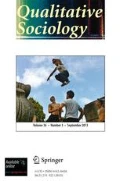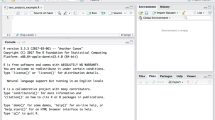Abstract
This paper is a short introduction to computer-aided content analysis in which words or phrases are the basic units. The advantages of computer-aided content analysis are noted and some general issues in its use discussed. Several ways of manipulating text by computer are then illustrated, including ordered word frequency lists, key-word-in-context lists, concordances, classifications of text in terms of content categories, category counts, and category-based retrievals from text. Although examples are based on Democratic and Republican platforms in presidential campaigns, these techniques can be applied to texts from a variety of sources, including in-depth and open-ended interviews, fieldnotes, letters, speeches, newspapers, books, and diaries, to cite a few examples.
Similar content being viewed by others
References
Aries, Elizabeth 1973 Interaction Patterns and Themes of Male, Female, and Mixed Groups. Unpub. Ph.D. Dissertation, Harvard University.
Aries, Elizabeth 1977 “Male-female interpersonal styles in all male, all female, and mixed groups.” Pp. 292–299 in Alice G. Sargent (ed.), Beyond Sex Roles. New York: West Publishing Company.
Berelson, Bernard 1952 Content Analysis in Communications Research. New York: The Free Press.
Berry-Rogghe, Godelieve L. M. 1973 “Computation of collocations in lexical studies.” In A. J. Aitken, R. W. Bailey, and N. Hamilton-Smith (eds.), The Computer and Literary Studies. Edinburgh: Edinburgh University Press.
Boden, Margaret 1977 Artificial Intelligence and Natural Man. New York: Basic Books.
Brent, Edward 1984 “Qualitative computing: Approaches and issues.” Qualitative Sociology (this issue).
Brunner, Ronald D. 1983 Forecasting growth ideologies. Discussion Paper No. 7. Boulder: University of Colorado Center for Public Policy Research.
Brunner, Ronald D. and Katherine Livornese 1982 Subjective political change: A prospectus. Discussion Paper No. 5. Boulder: University of Colorado Center for Public Policy Research.
—— 1983 The President's annual message. Discussion Paper No. 8. Boulder: University of Colorado Center for Public Policy Research.
Burnham, Walter Dean 1970 Critical Elections and the Mainsprings of American Politics: New York: Norton.
Burton, Delores M. 1981 “Automated concordances and word indexes: The process, the programs, and the products.” Computers and the Humanities. 15:139–154.
—— 1982 “Automated concordances and word-indexes: Machine decisions and editorial revisions.” Computers and the Humanities. 16: 195–218.
Carbonell, Jaime G. 1981 Subjective Understanding: Computer Models of Belief Systems. Ann Arbor: UMI Research Press.
DeWeese, L. C., III 1976 “Computer content analysis of printed media: A limited feasibility study.” Public Opinion Quarterly. 40:92–100.
—— 1977 “Computer content analysis of ‘day-old’ newspapers: A feasibility study.” Public Opinion Quarterly. 41:91–94.
Dunphy, D. C., C. G. Bullard, and E. E. M. Crossing 1974 “Validation of the General Inquirer Harvard IV Dictionary.” Paper presented 1974 Pisa Conference on Content Analysis.
Firth, J. R. 1957 “Modes of meaning.” In Papers in Linguistics 1934–51. London: Oxford University Press.
Geffroy, Annie, P. Lafon, Gill Seidel, and M. Tournier 1973 “Lexicometric analysis of co-occurrences.” In A.J. Aitken, R. Bailey, and N. Hamilton-Smith (eds.), The Computer and Literary Studies. Edinburgh: Edinburgh University Press.
Gerbner, George, Ole R. Holsti, Klaus Krippendorff, William Paisley and Philip J. Stone, eds. 1969 The Analysis of Communication Content. New York: John Wiley & Sons.
Gottschalk, L. A. 1979 The Content Analysis of Verbal Behavior: Further Studies. New York: SP Medical & Scientific Books.
Haskel, Peggy J. 1971 “Collocations as a measure of stylistic variety.” In R. A. Wisbey (ed.), The Computer in Literary and Linguistic Research. Cambridge: Cambridge University Press.
Hockey, Susan and Ian Marriott 1982 Oxford Concordance Program Version 1.0 Users' Manual. Oxford: Oxford University Computing Service.
Holsti, Ole R. 1969 Content Analysis for the Social Sciences and Humanities. Reading, Mass.: Addison-Wesley.
Johnson, Donald Bruce 1979 National Party Platforms 1840–1976 (2 vols.). Urbana: University of Illinois Press.
—— 1982 National Party Platforms of 1980. Urbana: University of Illinois Press.
Kelly, Edward F. and Philip J. Stone 1975 Computer Recognition of English Word Senses. Amsterdam: North Holland.
Klingemann, Hans-Dieter, Peter Philip Mohler, and Robert Philip Weber 1982 “Cultural indicators based on content analysis.” Quality and Quantity. 16:1–18.
Krippendorff, Klaus 1980 Content Analysis: An Introduction to its Methodology. Beverly Hills: Sage.
Lasswell, Harold D. and J. Zvi Namenwirth 1968 The Lasswell Value Dictionary. 3 vols. New Haven: Yale University, Mimeo.
Markoff, John, Gilbert Shapiro, and Sasha Weitman 1974 “Toward the integration of content analysis and general methodology.” In D. R. Heise (ed.), Sociological Methodology, 1975. San Francisco: Jossey-Bass.
Namenwirth, J. Zvi 1969a “Marks of distinction: A content analysis of British mass and prestige newspaper editorials.” American Journal of Sociology. 74:343–60.
—— 1969b “Some long and short term trends in one American political et al., The Analysis of Communication Content. New York: John Wiley.
—— 1970 “Prestige newspapers and the assessment of elite opinions.” Journalism Quarterly. 47:318–23.
—— 1973 “The wheels of time and the interdependence of value change.” Journal of Interdisciplinary History. 3:649–683.
—— 1983 “Why cultual indicators?” In Gabriele Melischek, Karl Erik Rosengren, and James Stappers (eds.), Cultural Indicators. Vienna: Austrian Academy of Sciences.
Namenwirth, J. Zvi 1984 “Value change and contrasts in communities of scientists, chemists, and economists since 1900.” In Robert Philip Weber and J. Zvi Namenwirth. Culture Indicators Research: A Content Analytic Perspective. Mimeo.
Namenwirth, J. Zvi, and Richard Bibbee. 1973 “Speech codes in the press.” Journal of Communication. 25:50–63.
Namenwirth, J. Zvi and Harold D. Lasswell 1970 The Changing Language of American Values: A Computer Study of Selected Party Platforms. Beverly Hills: Sage.
Namenwirth, J. Zvi and Robert Philip Weber 1984 “The Lasswell Value Dictionary.” In Robert Philip Weber and J. Zvi Namenwirth. Culture Indicators Research: A Content Analytic Perspective. Mimeo.
Ogilvie, Daniel M. 1966 “Procedures for improving the interpretation of tag scores: The case of Windle.” In P. Stone, et al., The General Inquirer: A Computer Approach to Content Analysis. Cambridge: MIT Press.
Ogilvie, Daniel M., Philip J. Stone, and Edward F. Kelly 1980 “Computer-aided content analysis.” In Robert B. Sjith and Peter K. Manning (eds.), Handbook of Social Science Research Methods. New York: Irvington.
Popko, Edward S. 1980 Key-Word-In-Context Bibliographic Indexing: Release 4.0 Users Manual. Cambridge Mass.: Harvard University, Laboratory for Computer Graphics and Spatial Analysis.
Preston, Michael J. and Samuel S. Coleman 1978 “Some considerations concerning encoding and concording texts.” Computers and the Humanities. 12:3–12.
Rosengren, Karl E. 1981 Advances in Content Analysis. Beverly Hills: Sage.
Shank, Roger C. and Robert P. Abelson 1977 Scripts, Plans, Goals, and Understanding. Hilldale, New Jersey: Erlbaum Associates.
Stone, Philip J., Dexter C. Dunphy, Marshall S. Smith, and Daniel M. Ogilvie 1966 The General Inquirer: A Computer Approach to Content Analysis. Cambridge: MIT Press.
Tufte, Edward R. 1978 Political Control of the Economy. Princeton: Princeton University Press.
Walker, Alvin W. The Empirical Delineation of Two Musical Taste Cutures: A Content Analysis of Best-Selling Soul and Popular Recordings from 1962–1973. Unpublished Ph.D. Dissertation. New School for Social Research.
Weber, Robert Philip 1982 “Society and economy in the Western world system.” Social Forces. 59:1130–1148.
—— 1982 “The long-term problem-solving dynamics of social systems.” European Journal of Political Research. 10:387–405.
—— 1983a “Content analytic cultural indicators.” In Gabriele Melishek, Karl Erik Rosengren, and James Stappers (eds.), Cultural Indicators. Vienna: Austrian Academy of Sciences.
—— 1983b “Measurement models for content analysis.” Quality and Quantity. 17:127–149.
Weizenbaum, Joseph 1976 Computer Power and Human Reason. San Francisco: W. H. Freeman.
Author information
Authors and Affiliations
Additional information
This research was supported in part by Kurzweil Computer Products, Inc., a subsidiary of Xerox Corp. Sue Williamson of Kurzweil played a key role, and her generosity and help is gratefully acknowledged. Randi Lynn Miller assisted with data entry at an earlier phase of research. Additional support has been provided by ZUMA, the Center for Surveys, Methods, and Analysis, Mannheim, FRG. For helpful comments and suggestions, thanks to Tom Davenport, Peter Mohler, J. Zvi Namenwirth, Philip J. Stone, and especially one anonymous reviewer. Thanks also to Kathy Tenerowicz for research assistance and to Barbara Norman for editorial assistance.
Rights and permissions
About this article
Cite this article
Weber, R.P. Computer-aided content analysis: A short primer. Qual Sociol 7, 126–147 (1984). https://doi.org/10.1007/BF00987112
Issue Date:
DOI: https://doi.org/10.1007/BF00987112




